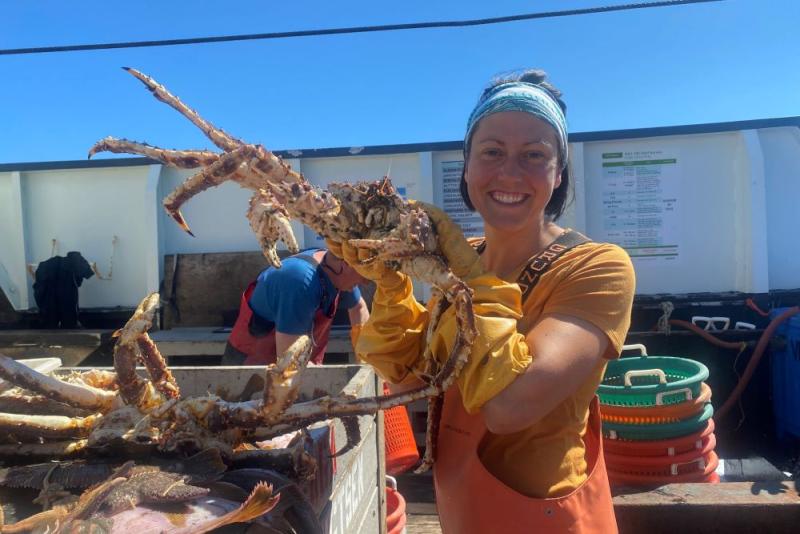Erin Fedewa joined the Alaska Fisheries Science Center in February of 2018 as a research fisheries biologist. Before joining us she did research at Oregon State, as a Fulbright Fellow in Trinidad and Tobago, and at Auburn University. She carries an infectious enthusiasm for her work and an innate curiosity for the world around her.
Erin’s colleagues have shared incredible stories of her talents in and out of the field. Mike Litzow, director of the Kodiak Laboratory and manager for the Shellfish Assessment Program, shared, “Erin is a total star… she has a real talent for building collaborations that have been super effective.”
Our Arctic and sub-Arctic fisheries depend on integrative science gathered from research surveys, observers on fishing vessels, ecosystem studies, and climate modeling. Research partnerships are also essential to helping us get our job done. Erin’s talent for creating connections helps us achieve our science mission.
A Rural Childhood Introduces Science Through Hands On Learning
I grew up on a farm in the Midwest so much of my childhood was spent outdoors. Agricultural and veterinary sciences were a part of my everyday life and the backyard was one giant science experiment, which fueled an insatiable curiosity about the world around me. I spent long summer days observing tadpoles in the pond, identifying and pressing Michigan wildflowers, and dumping the contents of my bug box to deduce my pet toad’s favorite insects to eat (my very first science experiment, much to my mother’s dismay). I figured that as one of the few 6th graders who avidly devoured biology textbook reading assignments, science was probably my calling. That, and the fact that I was convinced I was the first 12-year old to have discovered a real-life dinosaur egg in the backyard …
I spent long summer days observing tadpoles in the pond, identifying and pressing Michigan wildflowers, and dumping the contents of my bug box to deduce my pet toad’s favorite insects to eat (my very first science experiment, much to my mother’s dismay).
Overcoming Self Doubt With Independent Thinking
There have been times in my career when I’ve felt inadequate or had self-doubt. Completing a year of independent research in Trinidad and Tobago as a Fulbright Fellow following graduate school was a transformative experience in my career. I was, in every sense, a minority in Trinidad. Earning respect as a female scientist in a patriarchal society required conveying confidence, being kind to myself, and embracing the experience. Over the years, I’ve made a conscious effort to ward off that insidious internal critic. While I feel humbled to have so many brilliant, successful scientists to look up to at NOAA, I’ve made it a point to not compare myself to an unrealistic outcome. After all, Rome wasn’t built in a day!
STEM Students Benefit From Diverse Experiences
Dive into anything and everything! Extensively pursuing all STEM-related educational opportunities and exposing yourself to a variety of STEM career options will help clarify your interests and shape your decisions. I’m a huge proponent of education and outreach. I believe we as scientists have an obligation to share our knowledge and encourage younger generations to pursue careers in STEM. I’m looking forward to co-developing a middle school science educational unit on snow crab and climate change in Kodiak this fall. I can’t wait to share my experiences with students alongside hands-on classroom dissections. I believe that meaningful outreach experiences like these ultimately shape students into our future scientists.
I believe we as scientists have an obligation to share our knowledge and encourage younger generations to pursue careers in STEM. I’m looking forward to co-developing a middle school science educational unit on snow crab and climate change in Kodiak this fall.
Synergy Between Satisfying Childhood Curiosity And Service
For me, there’s so much joy and gratification in the long days, weeks, and months spent out on the Bering Sea. The survey data we provide are critical for managing some of the world’s largest fisheries and fulfilling that role in a very challenging and dynamic environment makes the work even more rewarding. Field work is not always the easiest part of my job, but marveling at all creatures big and small fulfills the childhood curiosity and excitement that motivated me to pursue a science career in the first place. My imagination always runs wild on the boat and I fully embrace it, admiring the constellations of color in each handful of sea stars and endless mountain ranges etched into Serripes notabilis, my favorite cockle shell.
Shedding Light On Snow Crab Population Dynamics In The Face Of Climate Change
I’m excited to continue developing collaborative industry and cross-divisional research projects to provide ecosystem information to managers and stakeholders under a changing climate. Several upcoming projects involving snow crab disease dynamics and an evaluation of snow crab population responses to climate extremes will hopefully help shed light on recent, large-scale snow crab population declines in the Bering Sea. We’re also working on a project to better understand if, and how snow crab energetic metrics vary in relation to recruitment dynamics and bottom temperatures in the Bering Sea.



